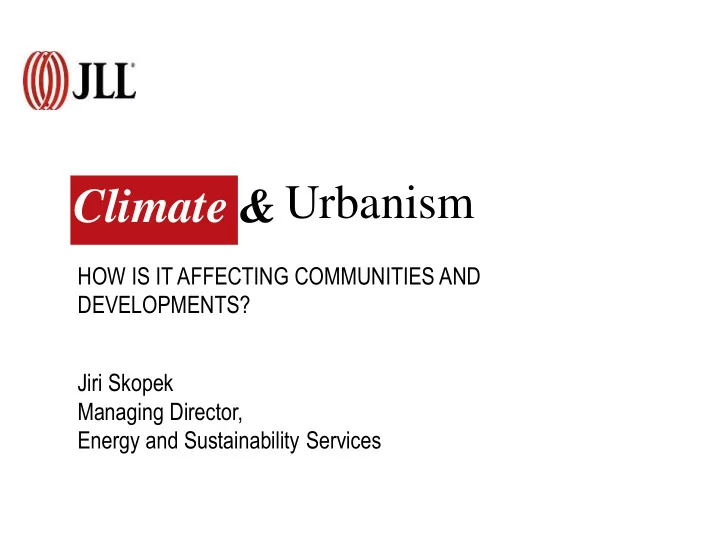

Urbanism Climate & HOW IS IT AFFECTING COMMUNITIES AND DEVELOPMENTS? Jiri Skopek Managing Director, Energy and Sustainability Services
Is it really getting hotter ?
Temperature projection scenarios
Temperature projection scenarios Business as usual 8 o C 7 o C 6 o C 5 o C 4 o C 3 o C 2 o C 1 o C 1950 2000 2050 2100 2150 2200
The coming climate crash Lessons from the 2008 Recession I feel as if I’m watching as we fly in slow motion on a collision course toward a giant mountain. We can see the crash coming, and yet we’re sitting on our hands rather than altering course. HENRY M. PAULSON Jr. Former U.S. Secretary of the Treasury New York Times June 21, 2014
Four Pillars of Emergency Management Risk Assessment Building Emergency Management Program Preparedness Mitigation Response Recovery Risk Assessment
Risk Assessment Flood Hazard Mapping Flood Risk Canada
Overview Step 1 – Risk Profile Step 2 – Four Pillars Individual Reports Portfolio Report Additional features Wind Is the building located in a region that is prone to hurricanes (i.e. what is the probability in this region in terms of frequency of hurricanes?) N. America: http://community.fema.gov/hazard/hurricane/besmart Asia Pacific: http://reliefweb.int/sites/reliefweb.int/files/resources/ Is the building located in a region that is prone to tornadoes or high winds? USA: http://rethinksurvival.com/net-guide/hazard-risk- assessment? Canada: http://www.theweathernetwork.com/news/articles/tornad oes-in-canada-everything-you-need-to-know/25876/1/1
Overview Step 1 – Risk Profile Step 2 – Four Pillars Individual Reports Portfolio Report Additional features utes) Risk Profile the lowest) risks A short questionnaire that generates a risk profile for your building with respect to natural, human or technical hazards pull up the t of weightings. indicated r/green. Continue tes) Pillars stionnaire for each “pillar” of agement The four pillars of emergency management are: Mitigation, Plans, Readiness and Recovery. There is a separate questionnaire for each pillar. Plans Mitigation questionnaire questionnaire Approximately 20 minutes Approximately 20 minutes This questionnaire evaluates features and procedures This questionnaire evaluates whether there are that will help to reduce the risk associated with a written emergency procedures. There are two particular hazard. Different types of hazards call for types of Plans: general aka “All - hazard” plans , different mitigation measures. and plans for specific hazards. Continue Continue Recovery Readiness questionnaire questionnaire Approximately 20 minutes Approximately 20 minutes This questionnaire evaluates whether there are This questionnaire evaluates the state of readiness to protocols to ensure a rapid return to “business as activate the plans. For example, is contact information up usual.” For example are there procedures to ensure to date? Is the necessary emergency equipment accessible that the building is safe to occupy? That insurance and in good working order? Are emergency personnel claims are submitted in good order? trained and practiced? Continue Continue
Mitigation flood Site -Low Impact Development (LID) strategies Grassy swales or bio-swales along roadsides • • On-site storm-water retention and detention basins Natural and constructed wetlands • Trees near buildings • • Vegetative buffers and islands in parking areas Permeable pavement • • Obtain easement rights Strategies for Resilient Buildings in Boston
Mitigation flood Building Safeguard toxic materials • Protect service equipment • Elevator equipment above flood zone and sealed • Water-tight construction (closures, sealants) • • Wet flood-proofing (allow water to enter and exit) Dry flood-proofing (barriers) • Pumps • Strategies for Resilient Buildings in Boston
Mitigation power failure • Generator (gas or diesel) above flood zone Consider co-gen and/or solar • Easy hook-up for temporary generators and • boilers Elevator back-up power or automatic return • • Elevator equipment above flood zone and sealed Prioritize which equipment will run on back-up • Obtain contract for fuel supply • Monthly procedures to test the back-up • generator under load conditions, including the switch gear and transfer switch and enough fuel
power failure Mitigation power failure Microgrid (small box retailer) power failure
Mitigation wind Protect windows and doors with covers, • hurricane shutters • Window film to prevent shattered glass injury Brace gable end roof framing • Retrofit cladding to prevent failure • • Anchor roof Windows • • Doors Strategies for Resilient Buildings in Boston
Mitigation earthquake • In new buildings, install cross bracing o steel bars in walls to reduce rocking o shock absorbing base isolators to absorb tremors o • In existing buildings Strengthen existing structures with reinforcing steel rods and steel frames around pillars • • Install fireproof materials and automatic shut-off valves in gas pipes
Community Resilience Adaptive capacity score Vulnerability score Source: RESILIENT CITIES A GROSVENOR RESEARCH REPORT
Recommend
More recommend